Assignment 7: Mutable Worlds
Goals: Further practice with ArrayLists; mutable worlds.
Instructions
This assignment is long. Start early.
As always, be very careful with your naming conventions.
The submissions will be organized as follows:
Homework 7 Problem 1: Sokoban, part 2.
Homework 7 Problem 2: The Automata.java file.
Due Date: Wednesday, March 12thThursday, March 13th at 9:00pm
Problem 1: Sokoban, Part 2
In this assignment, you’ll add enough behavior to Sokoban to make it a playable game. Plus, you’ll add a new extension to the game so far.
7.1 Design reflection:
You and your new partner each have an implementation of part 1 of the project. You will merge the best parts of your two designs together, as the starting point for this part of the project. You are allowed to revise any part of your prior designs: you can change data definitions, implementations, etc. You may change from Funworld to Impworld (see problem 2 below). You may use mutation...
...carefully! You are still expected to design your code well, meaning it should still be testable, readable, and understandable. Gratuitous use of mutability, untested void methods, etc., will be considered bad design. You now have lots of tools to express yourselves: part of the challenge of this problem is to express your design clearly.
Exercise
In a file Merging.txt, describe the similarities and differences between your two implementations. Explain which parts of whose implementations were kept (and why), and which parts were discarded (and why). Explain what primary changes you plan to make to your prior designs.
7.2 Player motion:
Exercise
There are a few rules of player motion:
A player can move at most one cell in any of the four cardinal directions (up, down, left, right), and cannot move on a diagonal.
A player cannot walk onto or through walls.
A player can stand on a target, and crates and trophies can be moved onto or off of targets.
If a player is adjacent to a crate or a trophy, and tries to move to that square, the player will push the item out of the way. (For example, if the player is to the left of a crate, and tries to move right, then the player will push the crate one cell to the right, and then move into the space formerly occupied by the crate. The same is true in the other directions.) But...
If a player is adjacent to a crate or a trophy, and that item is adjacent to another item (or a wall) in the same direction, then neither the item nor the player can move. Think of it as, the player is strong enough to push one item, but two items in a row are too heavy for the player to move.
There is no way for a player to “pull” an item (though that would be a fun extension of the game!) —
players can only push items around the board. In fact, determining if a level is winnable is proven to be an extremely challenging problem, and as far as Computer Science knows, cannot be solved any more cleverly than by brute-force trying every single player motion...
As before, the game ends when the player has won the level. You do not have to determine if the board is no longer winnable!Implement all the rules of the game above, to make your Sokoban game playable.
Here’s a fun introductory level to play, to get you started:

7.3 Pit traps:
Here we get a bit sneaky. We’ll add a new kind of tile: a hole:

Things can fall into a hole, and if something falls into a hole, it fills the hole, and both the thing and the hole vanish, leaving normal floor. If the player falls in a hole, the game ends. If a trophy falls in a hole, the trophy is lost forever.
Exercise
Enhance your data definitions from the previous part to incorporate these new holes.
Exercise
Enhance your rules of motion to account for holes, so that when an item is pushed into a hole (or the player falls in!), the item and the hole disappear. Enhance your stop-when condition so that the game ends when either the level is won or the player falls into a hole and vanishes.
Here’s a simple level with holes, to get you started:
 }
}
Exercise
In a file Changes.txt, explain:
What changes did you have to make to your data definitions from the previous assignment, and why?
Had you known in the prior assignment that holes would be arriving now, would you have designed your data differently?
If we were to enhance the game with new kinds of tiles in the next assignment, would your revised data definitions accommodate those changes more easily?
Problem 2: Cellular Automata and Mutable World Programs
A cellular automaton is a simplified model of a biological cell: it has a state, a short lifespan, and can produce a child cell in some state in response to its own state and to the state of its neighbors. When a collection of cellular automata are arranged in some fashion (in a line, or on a plane, or in a 3-d grid...), interesting collective behaviors can emerge. In this problem, we’re going to work with the simplest kind of cellular automaton, which has only two states (on or off), and we’re only going to work with a 1-dimensional collection of cells. As it turns out, even this simplified setting is enough for impressive patterns to emerge.
Before you begin the assignment below, add the following lines to the top of your Automata.java file:
import tester.*; // The tester library import javalib.worldimages.*; // images, like RectangleImage or OverlayImages import javalib.impworld.*; // the abstract World class and the big-bang library for imperative worlds import java.awt.Color; // general colors (as triples of red,green,blue values) // and predefined colors (Red, Green, Yellow, Blue, Black, White)
Be sure to use impworld, not funworld.
7.1 Individual cells
interface ICell { // gets the state of this ICell int getState(); // render this ICell as an image of a rectangle with this width and height WorldImage render(int width, int height); // produces the child cell of this ICell with the given left and right neighbors ICell childCell(ICell left, ICell right); }
Every cell has a state, but it might be computed in various ways, so ICells provide a getState method to compute it. We make the return type int in case you want to experiment with more sophisticated cell states than just on/off. For now, use 0 for an “off” cell, and 1 for an “on” cell.
Additionally, every cell needs to produce a picture of itself somehow. The render method should produce a picture that fits into a rectangle of the given width and height. You will use this method to render a collection of cells at various locations. You may draw cells however you like; in the pictures below, an “on” cell is drawn as a black square, while an “off” cell is white.
Finally, the childCell method lets a cell produce its child cell, in response to its own state and its neighbors’ states. We’ll describe this method in more detail, below.
7.2 Different kinds of cells
7.2.1 Inert cells
Define a class InertCell that implements ICell, and is always off. Its state is always 0. When it produces a child, it ignores its neighbors entirely and produces another InertCell.
7.2.2 Rule-based cells
A rule-based cell takes the states of its left and right neighbors, along with its own state, into account when producing a child cell. Since each of these three cells can be in one of two states, there are eight possible situations. For each of these eight possible situations, the child cell could be either on or off. Accordingly, there are 28 = 256 possible “rules” for implementing a rule-based cell. We can conveniently name these rules by reading off the outputs as bits, in order from left to right, and treating them as an 8-bit binary number. For example, here is rule 60:
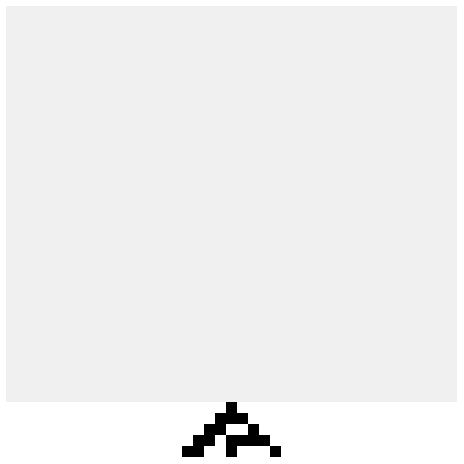
Read each of these images as saying (for example): “if the left cell is in state 1, this cell is in state 0, and the right cell is in state 1, then output a child cell in state 1.”
(We get the number 60 by reading the outputs as bits from left to right, so 0 * 27 + 0 * 26 + 1 * 25 + 1 * 24 + 1 * 23 + 1 * 22 + 0 * 21 + 0 * 20 = 60. We get the exponents by reading off the inputs as bits of a binary number, too.)
Design a class Rule60 that implements ICell, and implements the rule above.
Design a class Rule30 that implements ICell, and implements the rule below:
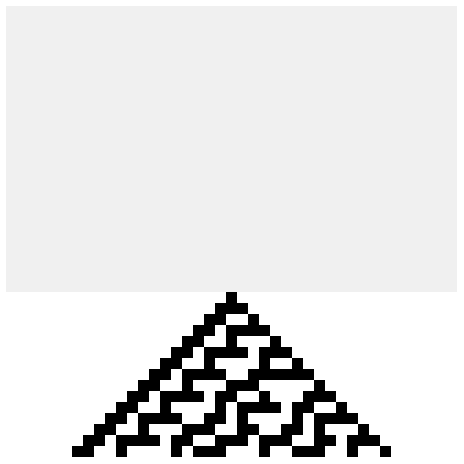
(Again, we get the number 30 by reading the outputs as bits from left to right, so 0 * 27 + 0 * 26 + 0 * 25 + 1 * 24 + 1 * 23 + 1 * 22 + 1 * 21 + 0 * 20 = 30.)
Abstract as much as you can. Implementing new classes, such as Rule182 or Rule54, should be much easier than copy-paste-modifying your existing code! Instead, look carefully for repeated code in these rule-based classes, and abstract it into an abstract base class (that still implements ICell). Then, simplify your concrete classes as much as possible. You may find this easier to do once you’ve finished the rest of the assignment and have it working, and can confirm (via tests!) that you won’t break anything.
7.3 Populations of cells
A population of cells will be a CellArray, which takes in just an ArrayList<ICell> in its constructor. Design a method CellArray nextGen() that produces a new generation of cells from the current population. Cells at the start and end of the list are treated as having InertCells as left and right neighbors, respectively.
It should also have a draw method, which takes in two numbers, representing the width and the height of an indiviual cell.
7.4 Animating your world
This code introduces two new keywords, static and final. For now, treat them as “magic words” and use these definitions as given. A partial explanation for them is that static lets you define things associated with a class rather than with an object, and final prohibits you from modifying a value once it’s been initialized. Taken together, and when used properly, they allow you to define constants like these, and the naming convention is to use ALL_CAPS_AND_UNDERSCORES.
class CAWorld extends World { // constants static final int CELL_WIDTH = 10; static final int CELL_HEIGHT = 10; static final int INITIAL_OFF_CELLS = 20; static final int TOTAL_CELLS = INITIAL_OFF_CELLS * 2 + 1; static final int NUM_HISTORY = 41; static final int TOTAL_WIDTH = TOTAL_CELLS * CELL_WIDTH; static final int TOTAL_HEIGHT = NUM_HISTORY * CELL_HEIGHT; // the current generation of cells CellArray curGen; // the history of previous generations (earliest state at the start of the list) ArrayList<CellArray> history; // Constructs a CAWorld with INITIAL_OFF_CELLS of off cells on the left, // then one on cell, then INITIAL_OFF_CELLS of off cells on the right CAWorld(ICell off, ICell on) { //TODO: Fill in } // Modifies this CAWorld by adding the current generation to the history // and setting the current generation to the next one public void onTick() { //TODO: Fill in } // Draws the current world, ``scrolling up'' from the bottom of the image public WorldImage makeImage() { // make a light-gray background image big enough to hold 41 generations of 41 cells each WorldImage bg = new RectangleImage(TOTAL_WIDTH, TOTAL_HEIGHT, OutlineMode.SOLID, new Color(240, 240, 240)); // build up the image containing the past and current cells WorldImage cells = new EmptyImage(); for (CellArray array : this.history) { cells = new AboveImage(cells, array.draw(CELL_WIDTH, CELL_HEIGHT)); } cells = new AboveImage(cells, this.curGen.draw(CELL_WIDTH, CELL_HEIGHT)); // draw all the cells onto the background return new OverlayOffsetAlign(AlignModeX.CENTER, AlignModeY.BOTTOM, cells, 0, 0, bg); } public WorldScene makeScene() { WorldScene canvas = new WorldScene(TOTAL_WIDTH, TOTAL_HEIGHT); canvas.placeImageXY(this.makeImage(), TOTAL_WIDTH / 2, TOTAL_HEIGHT / 2); return canvas; } }
The 5th, 15th and 25th generations for Rule 60 should look like this (shrunk to fit side-by-side here):
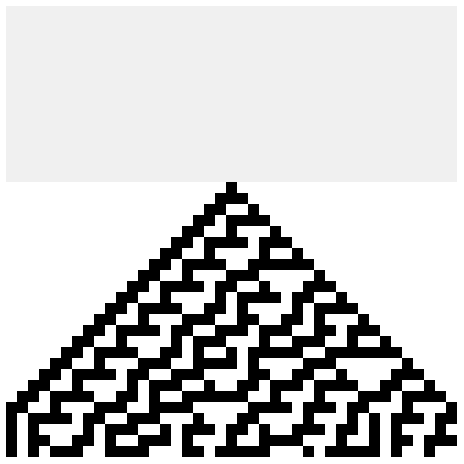
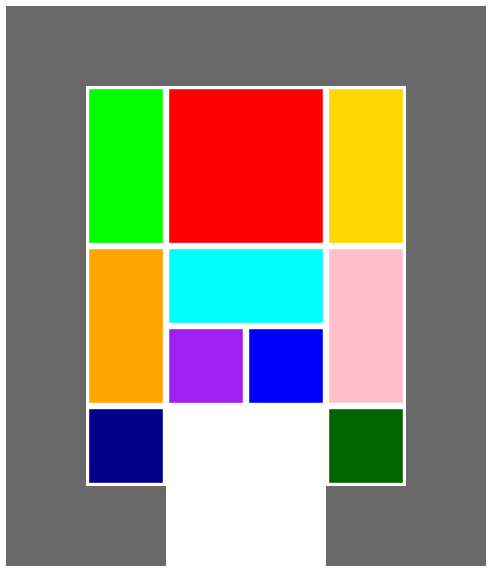
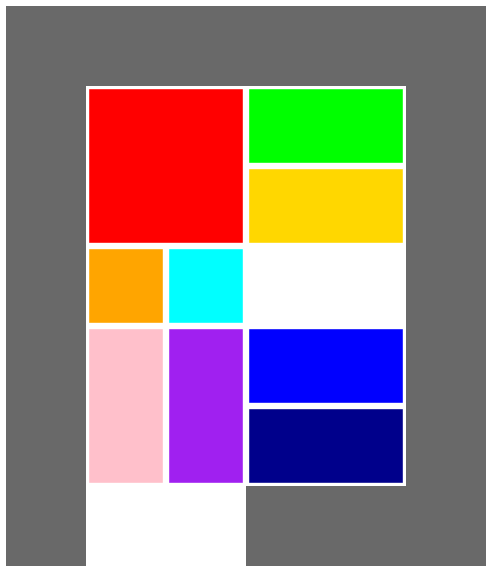
Likewise, the 5th, 15th and 25th generations for Rule 30 should look like this:

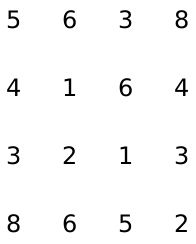
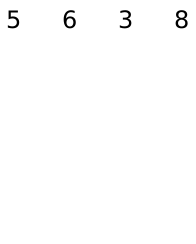
7.5 Optional Enhancements
Try designing a three-valued cell (states are 0, 1, 2), or a four-valued cell. Make up coloring rules for them, and make up rules for how the childCell method should work.
Try designing differently-sized neighborhoods, so that cells can see their four nearest neighbors (two on each side).